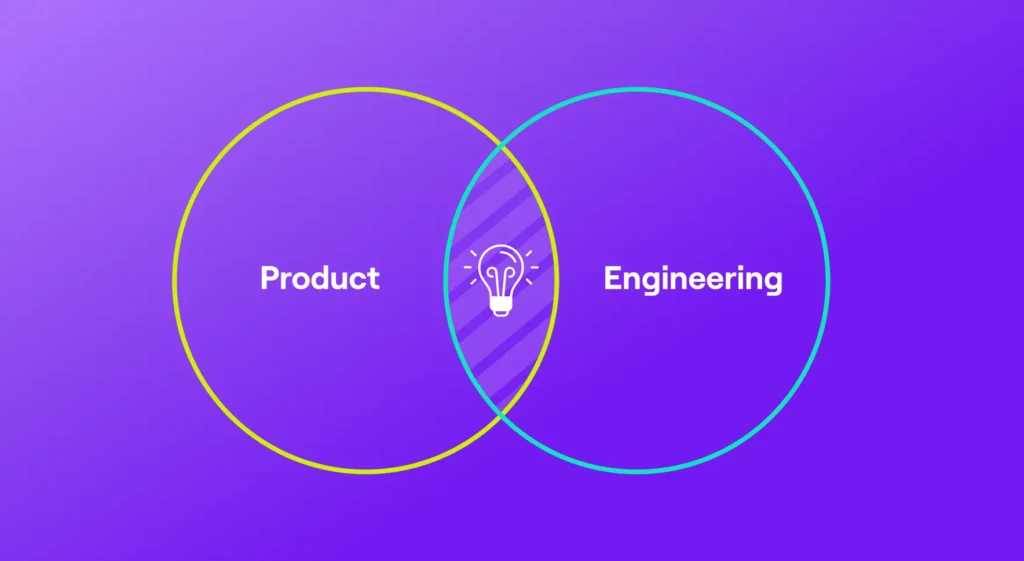This week’s post is authored by a special guest, Kate Brigham, VP of Product at Notarize. With over 15+ years of experience in product and design, Kate shares with us her reaction to one of our more recent posts and highlights the value of a strong relationship between Product and Engineering leaders.
In a recent post, Andrew described the challenges felt by those in Head of Engineering roles. He talked about how it feels when no one else in your company really understands the types of challenges faced by your team. While the roles might be very different on the surface, many Heads of Product face strikingly similar challenges themselves.
Like the Head of Engineering, the Head of Product role has its challenges. It requires constant trade-offs. Frankly, when the product role is done correctly, stakeholders are never going to be 100% satisfied with our decisions. Most Heads of Engineering can relate. In my mind, that sets us up to be natural allies.
I’ve had the privilege of working with many talented leaders of engineering and technology. The relationships we formed over the years were incredibly beneficial partnerships that made both roles much more effective. When you get it right, it’s a beautiful thing. Sadly, that’s not always the case. I have some theories about why that is, despite the many similarities in the challenges we each face.
The Head of Product takes a different approach to planning & prioritization
Left to our own devices, these two functions would be inclined to prioritize the work of their technical teams VERY differently. Heads of Products align product work to growth opportunities seen through market analysis and customer feedback. We rely heavily on outside sources to decide where resources should be allocated. We look at possible scenarios for what could be prioritized based on resource allocation, estimated project timelines, hiring increases, etc. The bottom line: Heads of Product are trying to optimize all of the resources at the company’s disposal to maximize market benefits.
Heads of Engineering might address this same question of work prioritization very differently, such as the sustainability of the software and tradeoffs around speed vs. quality. Code ownership and team charters also tend to factor in as does the desire to pay down tech debt. One of the challenges I’ve recently struggled to navigate is the preference for a stack-ranked list of priorities for teams to work on. Unless you have a single product offering or a team that can tackle any problem, it’s rarely that straightforward. Accomplishing meaningful business outcomes often requires coordinating resources across multiple teams without knowing the exact scope upfront, or which team(s) will be best suited to tackling the work. So, you end up playing a complex game of Jenga, especially when trying to help stakeholders understand options and make thoughtful, informed choices.
Why does this different approach matter? The Head of Product should (and hopefully wants to) factor in your input as an engineering leader. They need it to determine feasibility and capacity. They should also value your input into the proposed technical approach, what teams and developers are best suited to what work, how to best solve complex problems, and achieve shared goals. But, these conversations also require flexibility and decision-making using limited information and unknowns. The results of these conversations might also require new team structures or processes to work efficiently. Given the interconnectedness of our team’s work, aligning on an approach based on shared goals from the outset seems so much easier than trying to align later in the game.
The inevitable roadmap questions
Equipped with the knowledge from these conversations, and with detailed visibility into how work is progressing, your Head of Product can be your biggest ally when stakeholders come knocking at your door asking how development is going. (They ask us all the time too!) We can then help each other, by giving the same answers to the CEO or Head of Sales when the tough prioritization questions come our way.
Recently, I’ve been working with my partner in Engineering to look back at the impact of some of the work we did in response to Sales and Customer Success asks, to see if they had the impact we were hoping for. We’re using that to inform conversations going into H2 roadmap planning, and make a case for proposing new metrics around opportunity size and confidence related to specific Product and Engineering asks from those teams. Our goal is to validate and align earlier — with our key stakeholders — on what solutions are most likely to move the needle for which customers and prospects. That in turn will enable our teams to focus on doing detailed problem definition and estimates for the set of highest potential work. And hopefully, hit those outcomes that we all want to see, to move the business forward. Partnering during planning means we’re building a shared understanding of priorities, opportunities and feasibility. By starting out aligned, it’s a lot easier to back each other up as we move forward.
Taking the leap of faith
Our roles can move past our different approaches to prioritization and planning, but it takes regular, transparent communication. In many cases, it takes a leap of faith to trust this person. This level of trust can be a bit scary, especially for new business relationships. But honest collaboration on answers to these hypothetical questions, even if they are only best guesses, can go a long way. I know I’d much rather work together to align on a path forward than have one defined for me.
My years in product have shown me that neither of us needs to go it alone. While we can’t solve all of our challenges for one another, we can build a strong partnership that makes some parts of the job easier and gets us closer to business objectives and needs, sooner. We have more in common than you might think. The sooner we acknowledge that, the sooner we can step in to support each other and provide a much-needed ally who can definitely empathize with many of the challenges you face.
For more information about Notarize, please visit https://www.notarize.com.






